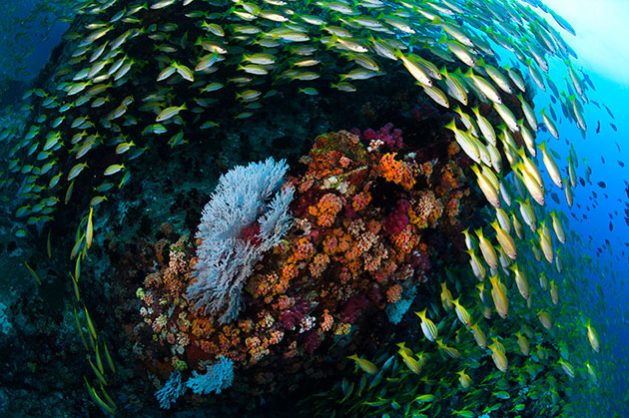Beware Carbon Myopia at COP28: Why Climate and Nature Action Must Now Come Together in the Race for a Liveable Planet

NEW YORK, Dec 6 2023 (IPS) - As COP28 delegates focus on the first Global Stocktake, there is no doubt that the race to net-zero greenhouse gas emissions is vital.
But while electric vehicles and solar power uptake have seen visible and welcome progress in particular, the transition to a thriving future on a healthy planet requires much more than decarbonization alone.
Don’t get me wrong. Decarbonization is a must. It has to be done. But focus on just one lane of what must be a systemic transition to a liveable planet is dangerously myopic.
Water vapor, for example, is overlooked as a highly significant greenhouse gas. It is the most abundant greenhouse gas, and responsible for about half of greenhouse heating effects. Recent research published in the International Journal of Environment and Climate change highlights that the quantities of water vapor in our atmosphere are affected by a breadth of environmentally damaging human activities, beyond fossil fuel emissions.
The oceans are the world’s biggest carbon sink and a weather and climate regulator in their own right. Harm to ocean ecosystem functions due to ocean acidification, toxic “forever chemicals” and microplastic pollution has led to reductions in phytoplankton photosynthesis by as much as 50 per cent since the 1950s. Phytoplankton photosynthesis underpins almost all marine animal life by generating most of the oxygen and food that provide other organisms with the chemical energy they need to exist.
This has knock-on implications deeply interlinked with climate action: reduced phytoplankton leads to higher concentrations of dissolved carbon dioxide in ocean surface water, further accelerating ocean acidification and allowing evaporation and atmospheric water vapor concentrations to increase, increasing humidity, precipitation and temperature as an additional climate change feedback loop.
Importantly, if we achieve net zero carbon by 2050, we could still face catastrophic climate change if ocean ecosystem health is overlooked. In addition to the consequences of global heating, ocean acidification and the collapse of the marine ecosystems could lead to the loss of most seals, birds, whales, fish, and food supply for three billion people.
Take another example: deforestation. In the past 300 years or so, 1.5 billion hectares of forest have been removed – an area roughly one and a half times the size of the US. Scientists have shown that ecosystems damaged by humans are more vulnerable to wildfires, which add to atmospheric carbon dioxide and cause excessive atmospheric heat to pass back to the ocean, releasing more water vapor and further increasing greenhouse gases.
Similarly, the increasing severity of devastating floods in recent years is not only linked to climate change but often also the result of forest and vegetation loss, land conversion, intensive land management and river straightening. Anthropogenic climate change is making extreme weather events more frequent and more severe, while human activity is also eroding the resilience of the environment to absorb these impacts.
Any narrow focus on something that is systemic is inherently problematic. Our planet’s multivarious ecosystems are deeply interconnected dynamic systems within which human activity is interwoven. We cannot silo our environmental challenges, nor our responses to them. Successful climate mitigation can be only achieved in the wider context of terrestrial and marine ecosystem health and social impact, measuring progress in lockstep with planetary health metrics and the sustainable development goals.
This is why it is beyond time to rethink our relationship with nature. Without a shift in how we value our natural environment and our relationship to it, we will always be trapped in a race against time to clean up after ourselves, treating only the symptoms of a dysfunctional relationship with our natural world, rather than the cause.
A revaluation of how humanity interacts with nature will bring the sea change we need. Protecting nature is too often falsely considered a trade-off against economic development, when the fact is that one helps the other: the collapse of ecosystem services would cost $2.7 trillion annually by 2030. The truth is that thriving, protected ecosystems are an exceptionally powerful development asset.
Not only is the protection of nature an absolute prerequisite for the success of climate action, but policies that preserve natural land could also increase global real GDP in 2030 in the order of trillions of dollars. This includes benefits through carbon sequestration, and through the multiple benefits that natural lands, waters and oceans provide.
The economic case for protecting nature by the World Bank found that restoring 350 million hectares of land could generate about $170 billion per year in net value by sequestering up to 1.7 gigatons of carbon dioxide equivalent annually and through watershed protection, improved crop yields and forest products.
As we race towards net zero, we must look with equal urgency at nature’s protection to ensure we decarbonize alongside progress towards ecological health and social stability on a superhighway of durable transition. Only change that accounts for humanity’s relationship with nature at a systemic level, its climate and its ecosystem health, will truly be a transition to thriving future on a liveable planet.
Midori Paxton is Director, Nature Hub, United Nations Development Programme
IPS UN Bureau
Follow @IPSNewsUNBureau
Follow IPS News UN Bureau on Instagram
© Inter Press Service (2023) — All Rights Reserved. Original source: Inter Press Service
 Global Issues
Global Issues